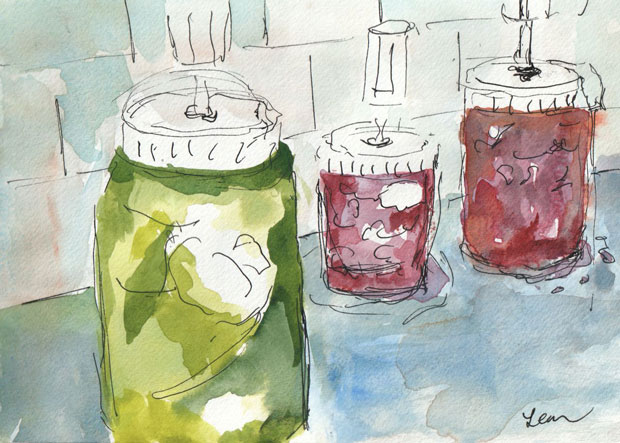Fermenting Experimenting

I’ve been experimenting with pickling and fermenting vegetables. I tried a macrobiotic recipe that just called for sea salt, water and kombu (seaweed) with vegetables, but I didn’t care for the result. Then I found a video that shows Sandor Katz teaching how he makes fermented cabbage. I tried it. We will eat the results on Friday night or Shabbat (I don’t care to wait a whole month). Sandor Katz wrote a book called Wild Fermentation. I ordered the book, and maybe after I read it, I will be able to explain why fermenting vegetables is good for you.
Notes: you do most of the work one day, and then a week or a month later you enjoy the results. That works well for those who like to plan ahead. Also, you will note both these videos talk about mold growing in the fermenting process (and Steve’s shows him throwing it away). Hmm, guess one has to get used to such things! My vegetables didn’t produce as much liquid as Sandor’s. But his recipe with cabbage, carrots, garlic and onion already tasted much yummier than the cucumbers in seaweed I tried last week. I hope to update you next week with photos of my finished product.

Ilana-Davita says
Did you use the same vegetables in the same proportions? He seems to put a lot of garlic in.
Did you use a glass jar?
Leora says
He doesn't give proportions. Yes, I am storing it in a glass jar. So far, it tastes good (16 hours later), though it tasted good last night, too.
Ilana-Davita says
But we can see how much he has at the beginning.
Leora says
I'm guessing it has less to do with amounts than with how hard he squeezes. All of these videos featured squeezing the vegetables - one (not one I showed) suggested a potato masher for squeezing.
I tried squeezing with a baby food jar, because it fit inside of my jar.
Leora says
And maybe it's also related to the salt - I think the salt on the vegetables is partly what makes the liquid come out. I added a little more salt and pressed some more.
Klara LeVine says
Leora,
I'm sure the amount of salt has ALOT to do with it. When I took a class I was told the liquid should taste salty like the sea. I tried once to make cucumber pickles and they were terrible so I hadn't tried again. But would love to. Mostly I just make quick radish pickles (2 cups water with 3 Tbsp. umeboshi paste simmered for 10 minutes - turn off flame, add bunch of very thinly sliced radishes - eat when radishes turn pink. Yum.
I also tried sauerkraut - and not sure it really fermented as it tasted just like salty cabbage! Thanks for the encouragement, I will try again.
Leora says
Yes, I think you are right about the salt.
Sandor did say in his book that you can add some brine (water+salt) to the top, so I did just that.
We ate some of my sauerkraut creation this past Friday night. The adults liked it. My middle son was brave enough to try it, but he said it tasted like marror. We will try it again next Friday night.
Klara LeVine says
I totally forgot to mention - a friend of mine would clean out her laundry room for Pesach a week before Pesach - and in the top of her Pesach items would be what she needed to make borscht, a knife, cutting board and a clean jar - and she'd have bought her new salt, so the beets would have a week to ferment. I'm not sure what I did with the recipe, maybe in my Pesach closet. Maybe Sandor has that in his book?
Leora says
Klara,
Yes, Sandor does have a recipe for beets. It's just beets, salt and caraway seeds, with the seeds as optional. Directly after he has a recipe for borscht.
I can't see myself making beets a week before Pesach, but I would consider straight cabbage fermented. Let's see - I would just need to find Pesach knife, cutting board, an unused glass jar, and something to press. Oh, and buy a new container of sea salt. Maybe.